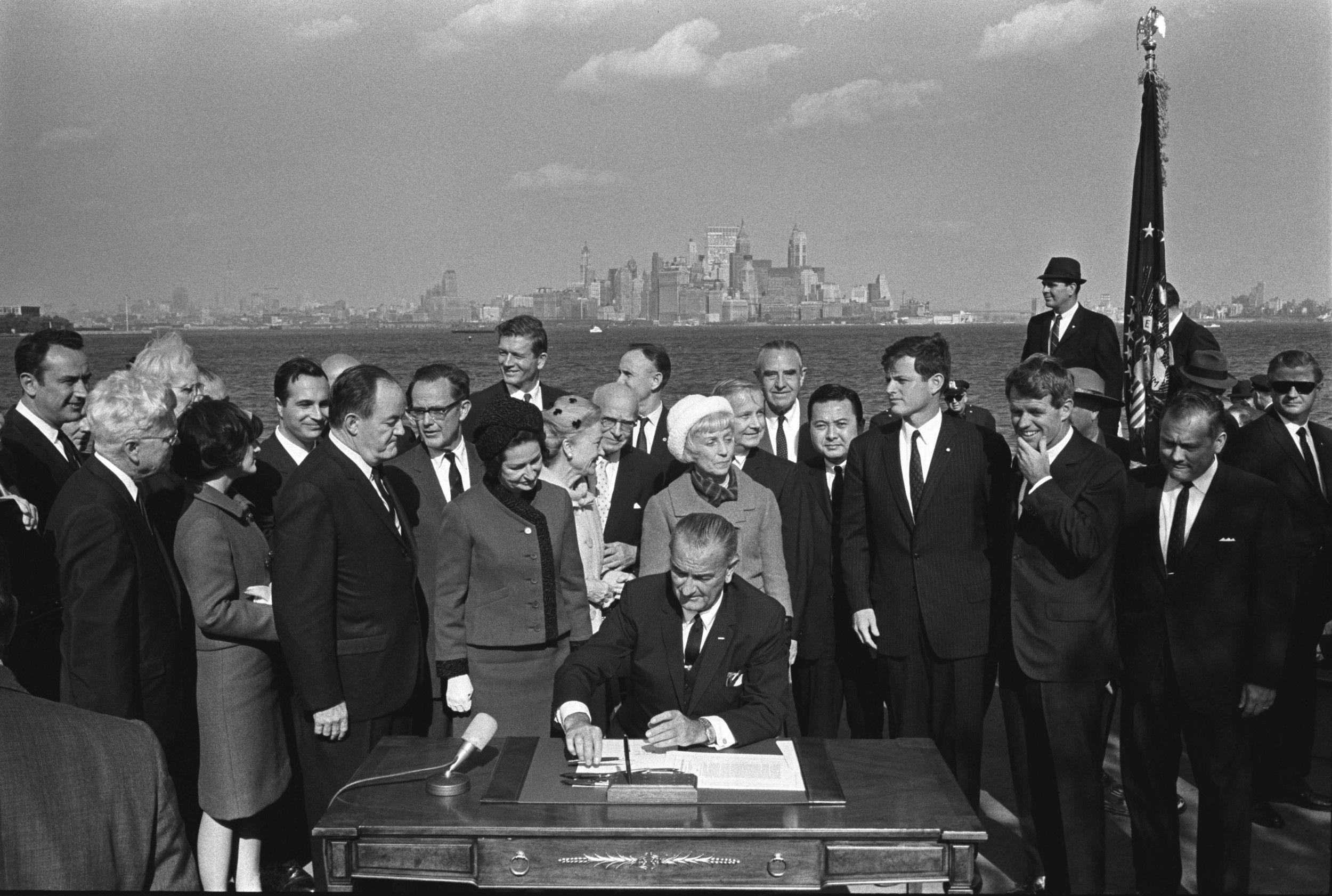President Lyndon B. Johnson Signing the Immigration Act
10/3/1965
Add to Favorites:
Add all page(s) of this document to activity:

In this photograph, President Lyndon B. Johnson signs the Immigration and Nationality Act of 1965 at the Statue of Liberty. Vice President Hubert Humphrey, Lady Bird Johnson, Muriel Humphrey, Senator Edward (Ted) Kennedy, Senator Robert F. Kennedy, and others look on.
This law was an important milestone in American immigration history. It ended the "national origins formula" that had been in place since the 1920s. From 1924 until 1965, following passage of the National Origins Act of 1924, a person’s place of birth often determined his or her ability to immigrate legally into the United States. Numerical limits, often called quotas, were assigned to each country.
Immigration laws favored people from northern and western Europe over those from southern and eastern Europe, Asia, and Africa. For example, about 4,000 Italians were allowed to enter the United States annually, while about 66,000 could emigrate from Great Britain. Asian immigrants, who generally entered the United States through Angel Island, were already largely banned from U.S immigration by other laws passed in the late 19th and early 20th centuries.
Potential immigrants needed to apply for spots on the quota in their country of birth, regardless of where they and their family lived. Some quota waiting lists were a dozen years long, while others were not filled.
The Immigration Act of 1965 abolished this quota system and eliminated the formally racial character of immigration to the United States. Rather than discriminating on the basis of ethnicity or race, the law authorized 120,000 immigration visas for people from the western hemisphere and 170,000 visas for people from the eastern hemisphere. It also prioritized keeping families together, and put a preference on skilled workers.
On August 25, the 1965 Immigration and Nationality Act, also known as the Hart-Cellar Act, passed in the U.S. House of Representatives with a vote of 318-95. On September 22, the U.S. Senate passed it with a vote of 76-18. President Johnson signed it into law on October 3, 1965.
The original caption for this photograph reads: Outdoor photograph, sunny day. Wide view of large group of people. Hubert Humphrey and Mrs. Johnson are looking down at President Johnson picking up pen. Ted Kennedy is looking to right of frame, and Robert Kennedy has hand up to chin, smiling. New York City skyline is in background.
This law was an important milestone in American immigration history. It ended the "national origins formula" that had been in place since the 1920s. From 1924 until 1965, following passage of the National Origins Act of 1924, a person’s place of birth often determined his or her ability to immigrate legally into the United States. Numerical limits, often called quotas, were assigned to each country.
Immigration laws favored people from northern and western Europe over those from southern and eastern Europe, Asia, and Africa. For example, about 4,000 Italians were allowed to enter the United States annually, while about 66,000 could emigrate from Great Britain. Asian immigrants, who generally entered the United States through Angel Island, were already largely banned from U.S immigration by other laws passed in the late 19th and early 20th centuries.
Potential immigrants needed to apply for spots on the quota in their country of birth, regardless of where they and their family lived. Some quota waiting lists were a dozen years long, while others were not filled.
The Immigration Act of 1965 abolished this quota system and eliminated the formally racial character of immigration to the United States. Rather than discriminating on the basis of ethnicity or race, the law authorized 120,000 immigration visas for people from the western hemisphere and 170,000 visas for people from the eastern hemisphere. It also prioritized keeping families together, and put a preference on skilled workers.
On August 25, the 1965 Immigration and Nationality Act, also known as the Hart-Cellar Act, passed in the U.S. House of Representatives with a vote of 318-95. On September 22, the U.S. Senate passed it with a vote of 76-18. President Johnson signed it into law on October 3, 1965.
The original caption for this photograph reads: Outdoor photograph, sunny day. Wide view of large group of people. Hubert Humphrey and Mrs. Johnson are looking down at President Johnson picking up pen. Ted Kennedy is looking to right of frame, and Robert Kennedy has hand up to chin, smiling. New York City skyline is in background.
This primary source comes from the Collection LBJ-WHPO: White House Photo Office Collection.
National Archives Identifier: 2803428
Full Citation: Photograph A1421-33A; Photograph of President Lyndon B. Johnson Signing the Immigration Act; 10/3/1965; Johnson White House Photographs, 11/22/1963 - 1/20/1969; Collection LBJ-WHPO: White House Photo Office Collection; Lyndon Baines Johnson Library, Austin, TX. [Online Version, https://www.docsteach.org/documents/document/lbj-immigration-act, April 25, 2024]Activities that use this document
- How Have Americans Responded to Immigration?
Created by the National Archives Education Team - Immigration to America: Stories and Travels
Created by the National Archives Education Team
Rights: Public Domain, Free of Known Copyright Restrictions. Learn more on our privacy and legal page.



